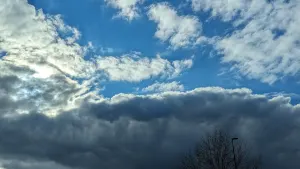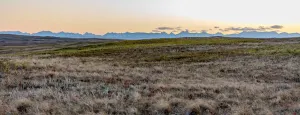
Don't miss out on these top winter astronomy events
A Boxing Day 'ring of fire' solar eclipse starts off a great season for winter skywatching
Winter is an exceptional season for skywatching and stargazing. With the longer nights, and cold, stable air overhead, there is more to see and the view is often crisper and clearer than at any other time of the year.
For Winter 2020, the very first big event takes place on the night of December 25, for those of us here in Canada (and the rest of the western hemisphere). It will not be one that we will see simply by looking up into the sky, though.
On that night, on the other side of the planet from us, viewers from Saudi Arabia, southern India and Southeast Asia will be watching as the Sun, Moon and Earth line up perfectly, to produce an annular solar eclipse.
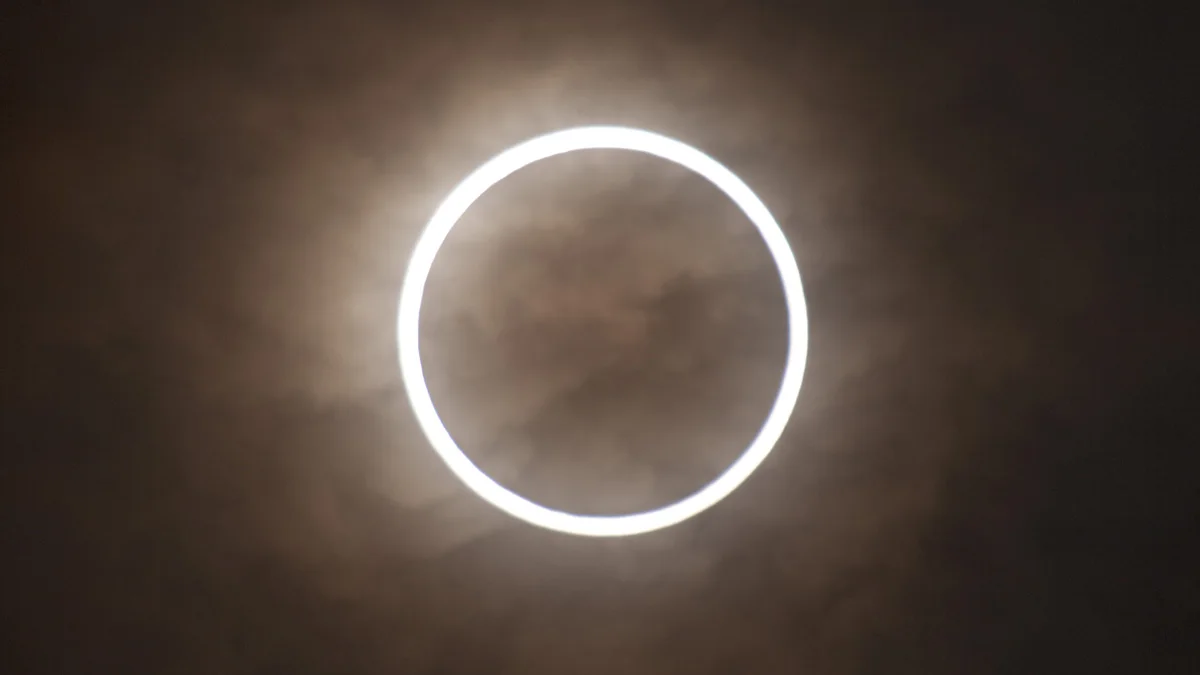
This image of an annular or 'ring of fire' eclipse was taken by Wikimedia user Nakae in 2012.
An annular solar eclipse occurs when the Moon passes directly in front of the Sun, but rather than covering it up entirely, a thin circle of the Sun's disk still visible around its edge. For this reason, these are sometimes called "Ring of Fire" solar eclipses.
This particular eclipse starts at dawn in Saudi Arabia, and the shadow of the Moon crawls across the eight different time zones over the course of roughly five and a half hours, before the event ends around sunset in the western Pacific Ocean.

The path of the annular solar eclipse on December 25-26, 2019. Credit: NASA/Fred Espenak/Scott Sutherland
Along the path of totality - the narrow strip of Earth's surface where the full eclipse will be visible - viewers have a chance to see the Sun as a blazing 'ring of fire' in the sky for about 3 minutes!
For viewers in Canada, the maximum eclipse occurs at 12:17 a.m. EST on December 26. Although we won't be able to watch it for ourselves, eclipses attract such attention that there will certainly be livestreamed events from along the path of totality. So, although we'll have to stay up late to watch it (after an undoubtedly long holiday day), will will not miss out on the show.
WINTER ASTRONOMY 2020
Dec 25-26 Boxing Day annular solar eclipse
Dec 28-29 Venus-Moon Conjunction
Jan 3-4 Quadrantids Meteor Shower Peak
Jan 5 Perihelion
Jan 10 Penumbral Lunar Eclipse
Jan 20 Mars-Moon Conjunction
Jan 23 Jupiter-Moon Conjunction
Jan 28 Venus-Moon Conjunction
Feb 11 Zodiacal Light (for 2 weeks)
Feb 17-20 Saturn-Jupiter-Mars-Moon Conjunctions
Mar 11 Zodiacal Light (for 2 weeks)
Mar 18-19 Saturn-Jupiter-Mars-Moon Conjunctions
Mar 20 Equinox (plus Saturn-Jupiter-Mars Conjunction)
PLANET-MOON CONJUCTIONS
All season long, the brightest planets in the sky will be teaming up with the Moon on various nights.
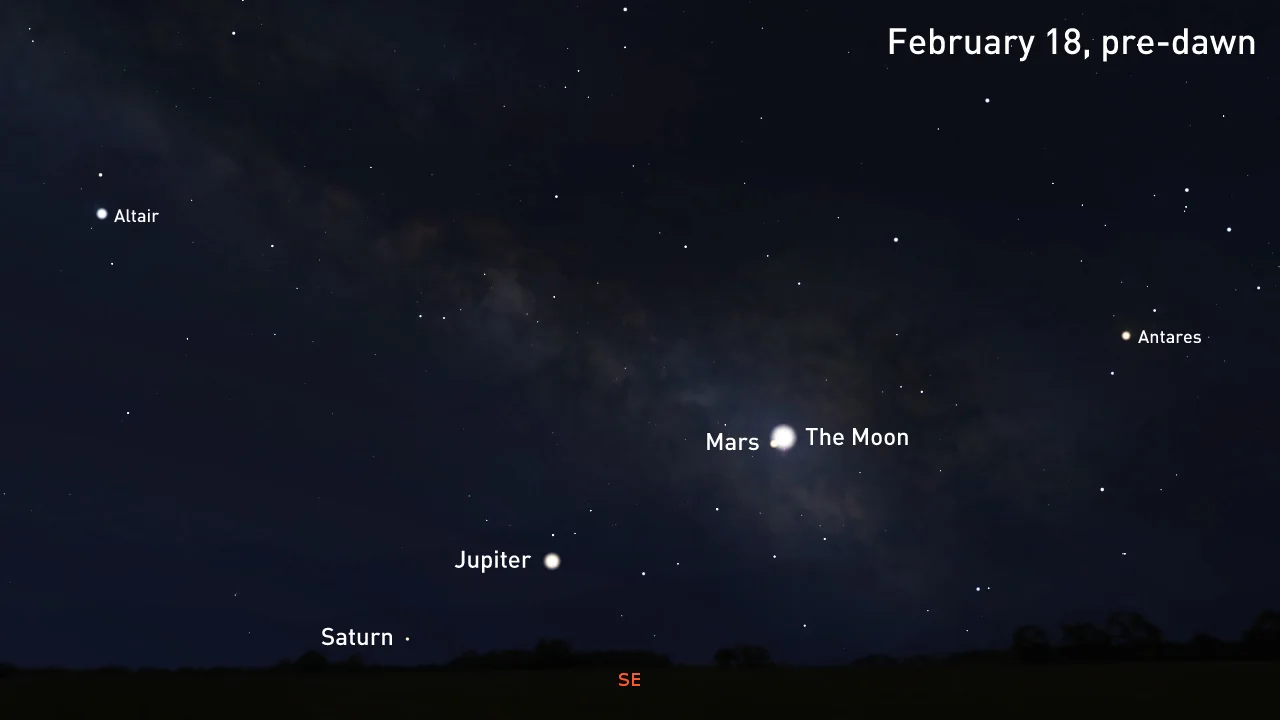
Saturn, Jupiter, Mars and the Moon put on a display together in the early morning sky of February 18. Watch this one from February 17 to February 20 to see the Moon pass by each planet in turn. Credit: Stellarium/Scott Sutherland
Watch for Venus and the Moon together on the evening of December 28, in the western sky. In January, between the 20th and 23rd, the Moon passes by Mars and Jupiter, but watch VERY carefully right at sunrise to spot Jupiter, and the Moon and Venus team up again on the evening of the 28th.
The early hours of February 17-20 and March 18-20 will be especially good, though.
On Febuary 17, the Moon, Mars, Jupiter and Saturn all line up in the eastern predawn sky. During the three mornings after, the Moon 'visits' each planet in turn (coming ESPECIALLY close to Mars on the 18th). Then, in March, there's a similar display, except the planets will be all bunched up on one another, with Jupiter and Mars very close together in the sky.
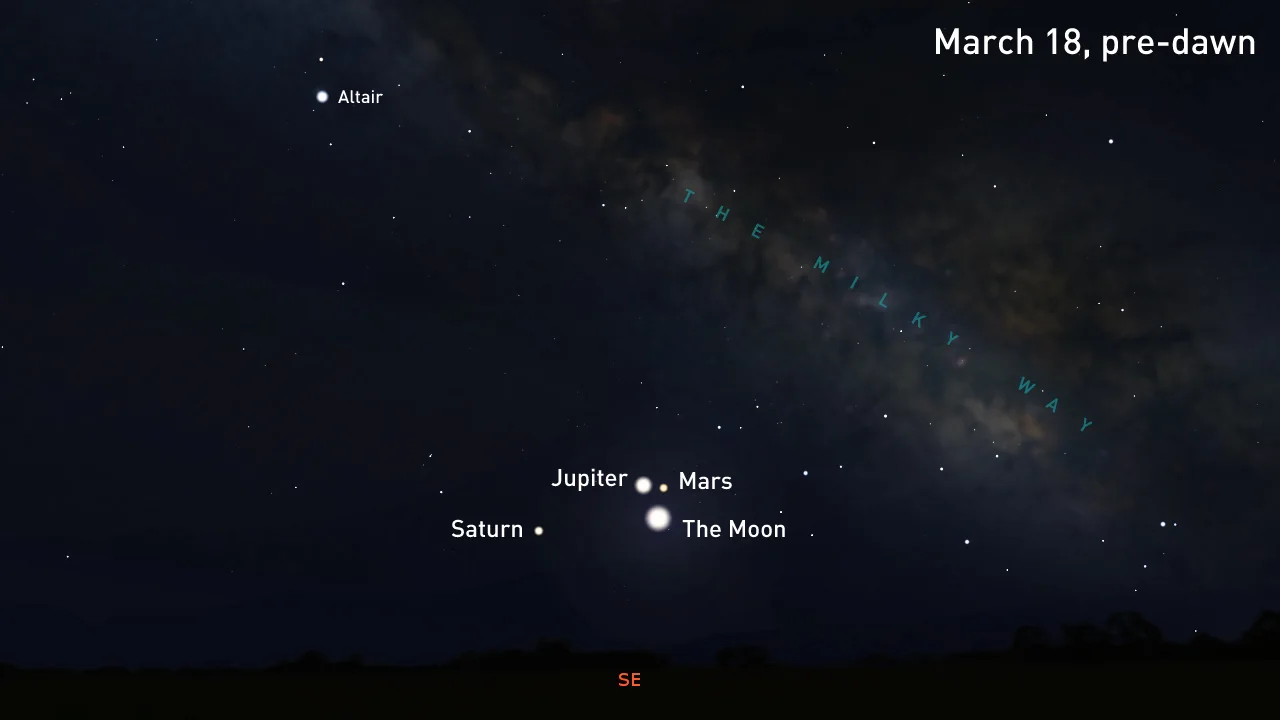
Saturn, Jupiter, Mars and the Moon form a tight cluster in the predawn sky of March 18. The planets will be arrayed in a similar formation on the following two nights, with the Moon lurking nearby. Credit: Stellarium/Scott Sutherland
JANUARY 3-4 - QUADRANTIDS METEOR SHOWER PEAK
The best of the winter meteor showers occurs right after New Years - the Quadrantids.
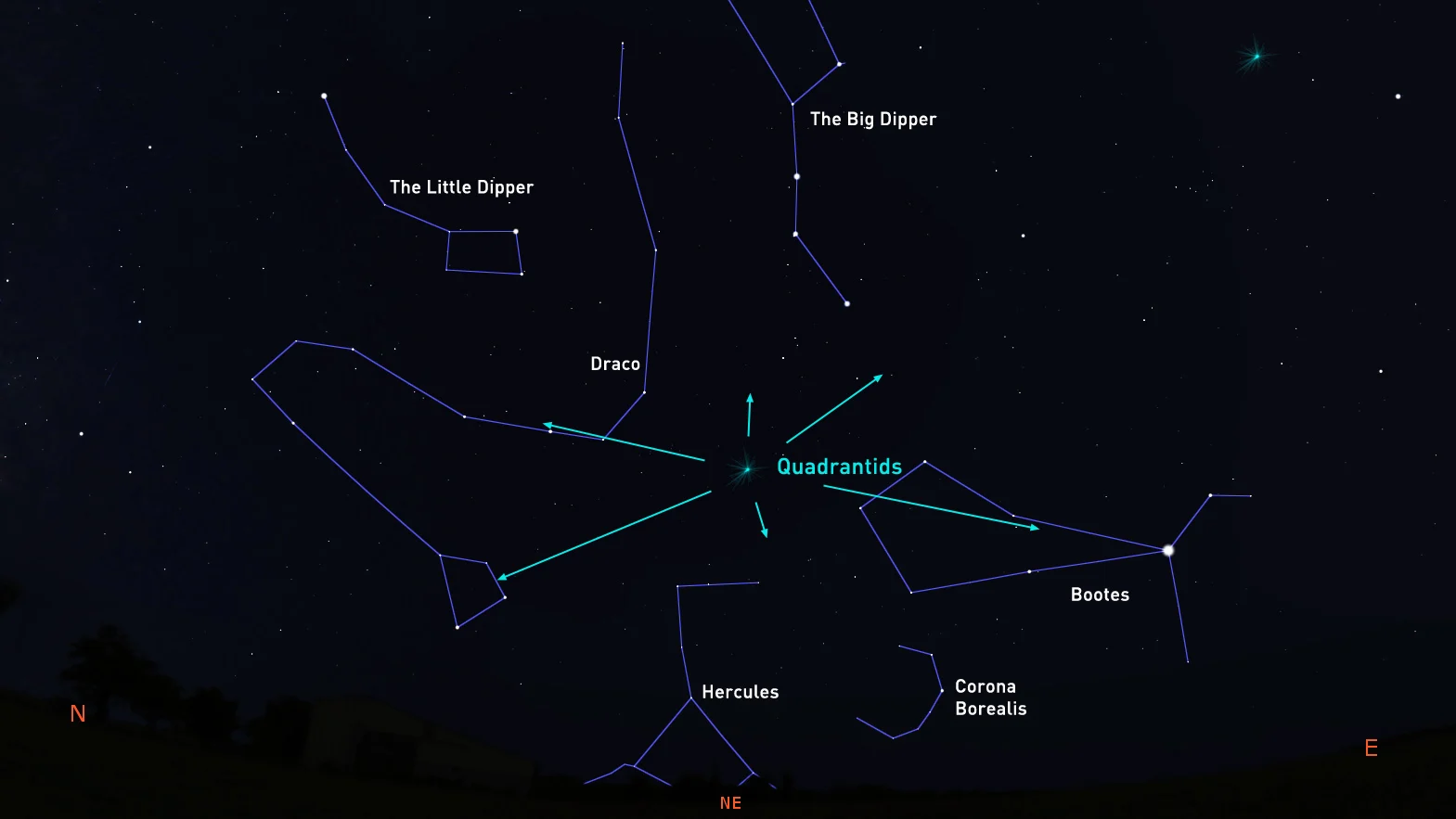
The location of the Quadrantid radiant, on the night of January 3-4, 2020. Credit: Stellarium/Scott Sutherland
According to the International Meteor Organization, this year's Quadrantids peak will occur on the night of January 3-4, at 8 UTC, or around 3 a.m. ET.
Normally, as Earth rotates into the stream of the meteors, the timing of the shower will be the same for each observer, based on their local clock. Due to the Quadrantids' very brief 4-hour peak, however, observers should adjust their viewing time accordingly.
Thus, viewers in eastern Canada should expect the peak a bit later, and viewers in western Canada should expect it a bit earlier in the night, based on their local time zone.
For this year's peak, the Moon will already be up in the sky as the night begins, however it will be in the western sky so it should not interfere too much with the meteor shower. Also, it will set shortly before the shower reaches its peak leaving good viewing conditions for the rest of the morning.
The Quadrantids, which originate from an asteroid known as 2003 EH1 (possibly an 'extinct comet'), is one of only two known meteor showers to originate from a rocky body! The December Geminids is the other, originating from 'rock comet' asteroid 3200 Phaethon.
This meteor shower is capable of putting on excellent displays, delivering an average of 120 meteors per hour under absolutely ideal conditions (clear, dark and dry skies). This can vary year to year, from around 60 to close to 200, and includes all meteors, from the brightest to those too dim to be noticed by the human eye.
JANUARY 5 - PERIHELION
Perihelion isn't necessarily something you can see. It's just something to experience, as Earth passes through its closest distance to the Sun for the year.
To mark the exact moment of this event, even to pause for a short break while watching the Quadrantids peak, it will occur at exactly 07:48 UTC, on January 5.
4:18 a.m. Jan 5 Newfoundland Standard Time
3:48 a.m. Jan 5 Atlantic Standard Time
2:48 a.m. Jan 5 Eastern Standard Time
1:48 a.m. Jan 5 Central Standard Time
12:48 a.m. Jan 5 Mountain Standard Time
11:48 p.m. Jan 4 Pacific Standard Time
So, what's up with perihelion? The Earth's orbit is almost circular, but not quite. Because the planet follows an elliptical path around the Sun, there's a point where we reach the closest distance to the Sun, and there's another point (called aphelion) where we reach the farthest distance from the Sun.
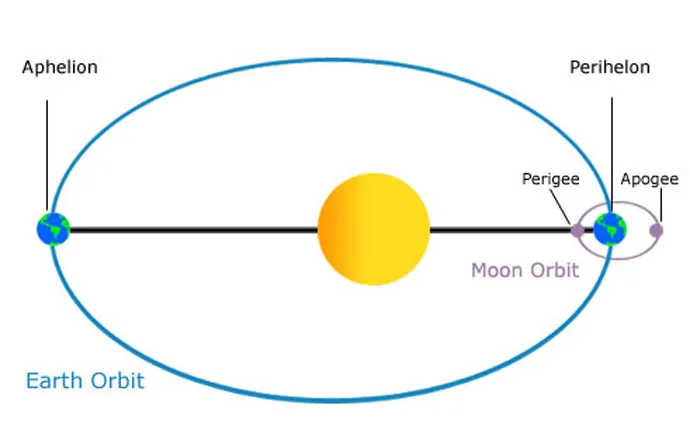
This diagram shows an exaggerated view of Earth's orbit around the Sun, to illustrate how the distance changes between perihelion and aphelion. Credit: NASA
Perihelion distance changes from year to year, mainly due to the influence of the Moon's gravity.
Remarkably, according to the site astropixels.org, Perihelion 2020 is the closest of this entire century, from 2001-2100, at a distance of 147,091,144 km. NASA records list the last year we saw a closer perihelion distance as 1996.
Right now, with the configuration of Earth's orbit and tilt, perihelion happens to be in the middle of northern Winter, while aphelion occurs in northern Summer. With the difference being only around 7,000 km, compared to the overall distance of 150 million km, the effect on temperatures is very small, though.
JANUARY 10 - PENUMBRAL LUNAR ECLIPSE
Ready for a challenge?
On the afternoon of January 10, on the other side of the planet from Canada, the Moon will be passing through part of Earth's shadow, producing a lunar eclipse.
This one will not only be impossible for much of Canada to see directly from here, but it might not be noticed at all, even by people directly underneath it.
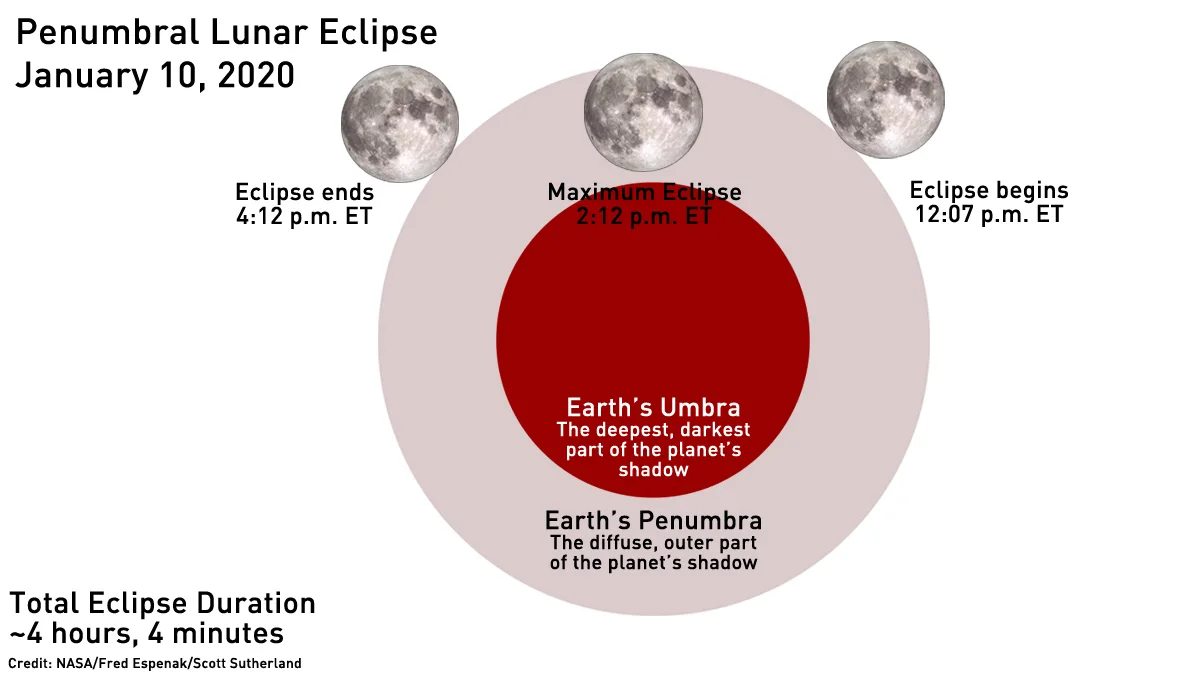
This illustration shows the path the Moon takes through Earth's shadow on January 10, 2020. It passes only through the northern part of the penumbra - the defuse outer part of Earth's shadow. No part of the Moon is expected to turn red during this eclipse.
Penumbral lunar eclipses occur when the Moon passes through the penumbra - the outer, diffuse part of Earth's shadow. While passing through the umbra will turn the Moon a dusky red colour, the penumbra simply turns the moon a slightly darker shade of grey.
In this case, if viewers in Atlantic Canada and northern Quebec want to test their skills, they can try see the eclipse already in progress right as the Moon is rising on January 10.
Eclipse enthusiasts will likely be on hand to witness this one from more favourable locations. So, we may see images showing up on the internet, or possibly even a livestream, but it will take some sharp eyes to see the changes the Moon goes through during this event.
THE ZODIACAL LIGHT
In winter, sharp-eyed skywatchers will have a chance to spot an elusive phenomenon known as "The Zodiacal Light".
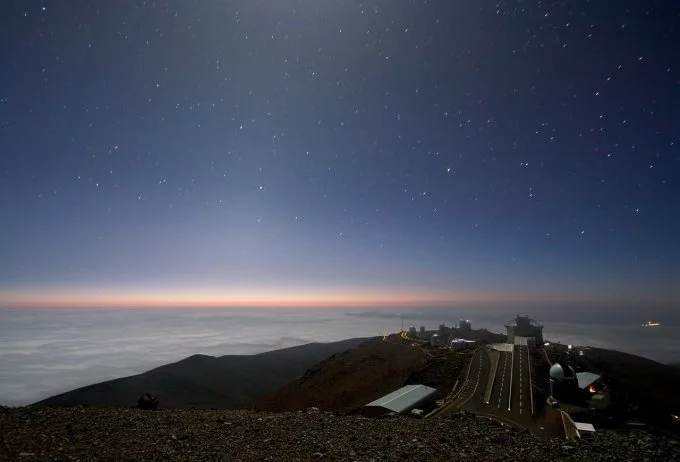
Moonlight and zodiacal light over La Silla. Credit: ESO
In the Royal Astronomical Society of Canada's 2019 Observer's Handbook, Dr. Roy Bishop, Emeritus Professor of Physics from Acadia University, wrote: "The zodiacal light appears as a huge, softly radiant pyramid of white light with its base near the horizon, and its axis centred on the zodiac (or better, the ecliptic). In its brightest parts, it exceeds the luminance of the central Milky Way."
The zodiacal light is caused by sunlight refracting off tiny bits of dust and ice that orbit around the Sun in the plane of the ecliptic (the same plane the planets orbit in). It is thought that this cloud originates from dust and ice blown off of comets.
According to Dr. Bishop, even though this phenomenon can be quite bright, the light is so diffuse that it can easily be spoiled by moonlight, haze or light pollution. Also, since it is best viewed just after twilight, the inexperienced sometimes confused it for twilight, and thus miss out.
On clear nights, and under dark skies, look to the western horizon, in the half an hour just after twilight ends, from about February 11 through to February 25. It can also be seen from March 11 through to around March 25.
The best mornings to try to see this phenomenon are likely from February 22-24, and March 23-25, since those are the days on or around the New Moon, and there will be little to no moonlight to spoil the view.
Look for a pyramid-shaped white glow, with the base along the horizon and the point angled towards the south.
MARCH 20 - SPRING EQUINOX IN THE NORTHERN HEMISPHERE
At precisely 3:50 UTC on March 20 (11:50 p.m. EDT March 19), the Sun will cross the celestial equator, from south to north, signifying the start of astronomical spring!
Additionally, due to Daylight Saving Time, and the fact that 2020 is a leap year, this is the earliest vernal equinox we've seen in 124 years. The last time the equinox fell on March 19, was way back in 1896!
What does all that mean? Well, as our Earth travels in its orbit, the 23.5° tilt of the planet causes the angle of the Sun to change in our sky.
From late September to late March, the North Pole is angled away from the Sun, so that the Sun is positioned more directly over the southern hemisphere, and the Sun reaches its lowest point in the northern sky (and highest in the southern sky) on or around December 22.
From late March to late September, conversely, the South Pole is angled away from the Sun, so that the Sun is positioned more directly over the northern hemisphere, reaching its highest point in the northern sky (and lowest in the southern sky) on or around June 22.
At the two points in between these periods - specifically around March 20 and September 22 - it appears to us as though the Sun crosses the equator. In March, it crosses from south to north, and in September, it crosses from north to south.
The exact moment that the Sun appears to be over the equator, in either case, is known as an Equinox.
Which hemisphere you're in at the time determines exactly which kind of equinox you're experiencing. In March, the northern hemisphere marks the vernal equinox, while the southern hemisphere marks the autumnal equinox. In September, it's the opposite.
Also, while it officially occurs a few hours AFTER the equinox, be sure to check out the eastern sky in the hours just before sunrise, to see Jupiter, Mars and Saturn all clustered together.








